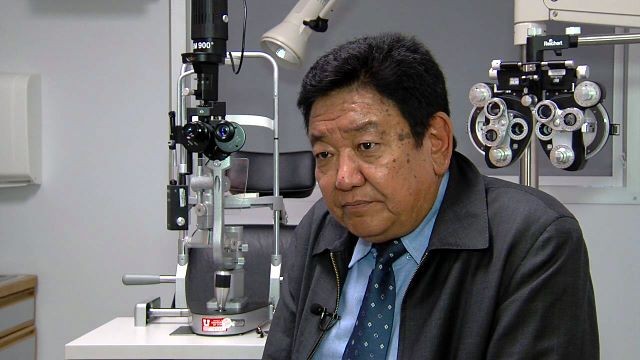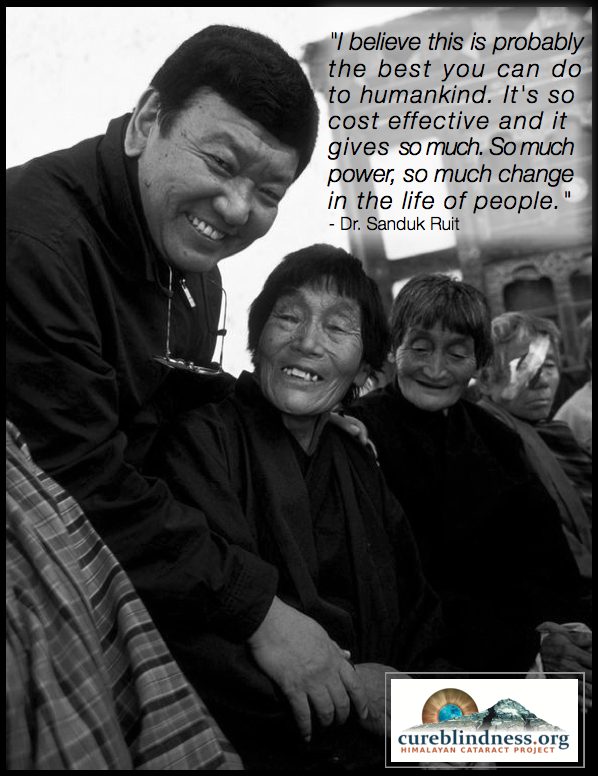
Sanduk Ruit grew up in a small village in the
Himalayas so isolated that the nearest school was a week's walk away.
When he was 17, his sister died of tuberculosis despite the disease
being treatable. The loss left Ruit with a sense of urgency to pursue a
path that benefited others, not only himself. It's a decision he doesn't regret.
"I am so grateful that I can make a difference in so many people's lives,"
It takes Sanduk Ruit about five minutes to change someone's life. In
that time, the Nepalese doctor can make a small incision in his
patient's eye, remove the cloudy cataract impairing her vision and
replace it with an inexpensive artificial lens.
"Some of our younger surgeons even do it faster than that," Ruit.

For many patients, it's the first time they've seen in years, if not decades. In
the past 30 years, Ruit has personally restored the sight of more than
100,000 people across Asia and Africa, and taught his rapid-fire
technique to countless other eye surgeons in parts of the world as
isolated as North Korea.
His patients
suffer from eye conditions that are mostly preventable. But because of
poverty and limited access to public health services they have been
unable to seek treatment.
Their story is all too common in the
developing world. An estimated 39 million people are blind worldwide,
according to the World Health Organization. Of these, around 90% live in
low-income areas and 80% suffer from conditions that can be prevented
or cured.

Driven
by a belief that the world's poorest people deserve safe, affordable
and high-quality eye care just as much as anyone else, Ruit has made it
his mission to eradicate avoidable blindness.
In 1994, he joined the late Australian ophthalmologist and philanthropist Fred Hollows,
who was his mentor and close friend, in establishing Tilganga -- an eye
hospital in Kathmandu dedicated to providing world-class eye care to
the people of Nepal.
The hospital manufactures state-of-the-art
lenses that are commonly used in treating cataracts or myopia, and
exports them to more than 30 countries worldwide.

For
those who cannot reach urban areas, Ruit and his team conduct mobile
eye camps in remote parts of Nepal and neighboring countries, often
trekking for days and cleaning out structures like tents, classrooms or
even animal stables for use as temporary operating theaters.
When the eye patches come off the day after an operation, it's an incredibly moving moment for all involved.
Amendolia, who described Ruit as "a
maverick in some ways," accompanied the Nepalese surgeon on one of the
first trips to North Korea in 2006.
The
Communist state is notoriously closed off to Westerners. International
aid workers frequently struggle to reach those most in need, in a
country where two-thirds of the population experiences chronic food
shortages, according to the United Nations.

But
Ruit, who believes in leaving politics to world leaders, had persuaded
the North Korean authorities to allow his team to conduct the 2006
surgery and training session in the south-eastern city of Haeju after he
had treated one of their diplomats stationed at the embassy in
Kathmandu.
"It was very restrictive,"
said Amendolia. "We made the same path from the hotel in Haeju, the same
way every day to the hospital, the same way exactly back and that's all
we saw of Haeju for the seven or so days that we were there."
Amendolia
describes how the North Korean surgeons, who came from across the
country, were so eager to learn that they huddled close to Ruit, leaning
over the operating table to get a better look as he worked.
"I've never seen an eye operation where (Ruit) had so many surgeons around him," he said.
One of the most moving images in
Amendolia's collection is that of an 80-year-old North Korean man who
sees his son for the first time in 10 years after being completely blind
in both eyes.

The absolute joy of an 80-year-old man sees son for the first time in a decade. "Of
course, the man who's had the operation is so relieved because he can
see again, but the whole family suddenly have a family member who can
participate again in everything that happens as home," Amendolia said.
Patients
who are blind in both eyes require constant care, placing a burden on
their families that can keep them trapped in a cycle of poverty. But
this quick-healing surgery allows them to regain their independence.
The
same transformative moment is played out for long-neglected patients in
the mountains of Nepal, the islands of Indonesia and rural China.

repost from CNN